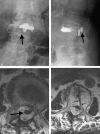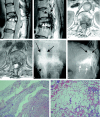Intraspinal leakage of bone cement after vertebroplasty: a report of 3 cases
- PMID: 16418389
- PMCID: PMC7976087
Intraspinal leakage of bone cement after vertebroplasty: a report of 3 cases
Abstract
We report 3 cases of vertebroplasty-induced intraspinal leakage of bone cement that were referred to us for management. Two patients received decompressive surgery, and one received rehabilitation. The gross surgical finding of yellowish dura mater and intradural fibrosis, adhesion, and microscopic finding of arachnoid membrane fibrosis are suggestive of late effect of thermal injury. These patients had residual lower extremity weakness and urinary and stool problems 13 months, 3 years, and 4.75 years post-vertebroplasty, respectively.
Figures




References
-
- Galibert P, Deramond H, Rosat P, et al. Preliminary note on the treatment of vertebral angioma by percutaneous acrylic vertebroplasty. Neurochirugie 1987;33:166–68 [in French] - PubMed
-
- Cotten A, Dewatre F, Cortet B, et al. Percutaneous vertebroplasty for osteolytic metastases and myeloma: effects of the percentage of lesion filling and the leakage of methyl methacrylate at clinical follow-up. Radiology 1996;200:525–30 - PubMed
-
- Deramond H, Depriester C, Galibert P, et al. Percutaneous vertebroplasty with polymethylmethacrylate. Technique, indications, and results. Radiol Clin North Am 1998;36:533–46 - PubMed
-
- Harrington KD. Major neurological complications following percutaneous vertebroplasty with polymethylmethacrylate: a case report. J Bone Joint Surg 2001;83-A:1070–73 - PubMed
Publication types
MeSH terms
Substances
LinkOut - more resources
Full Text Sources
Medical
